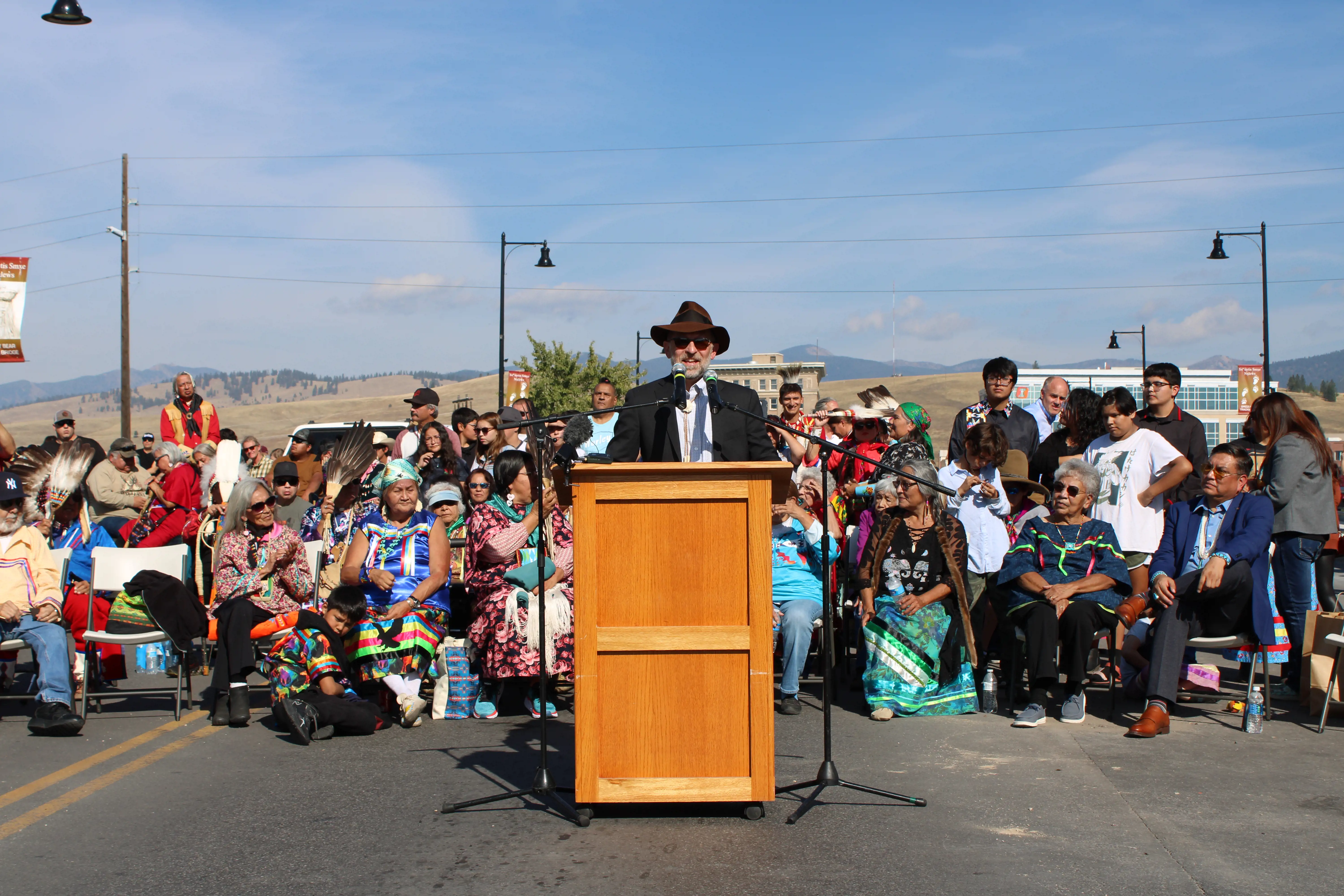Honoring A Prominent Salish Family
In 2020, the Missoula County commissioners, led by Commissioner David Strohmaier, approached the Confederated Salish and Kootenai Tribal Council and the Séliš-Ql̓ispé Culture Committee (SQCC) to discuss the possibility of renaming the Higgins Ave. bridge that spans the Clark Fork River, which was under reconstruction at the time. With an understanding that Missoula has always been at the heart of the overlapping territories of the Séliš and Ql̓ispé (or upper Kalispel or “Pend d’Oreille”), the process of officially naming Beartracks Bridge began.
The Tribal Council and Culture Committee welcomed the commission’s consultation. After careful research and several meetings, the Séliš-Ql̓ispé Elders Cultural Advisory Council reached consensus on the new name, which many family members supported and the Tribal Council endorsed.
As Missoula continues to grow and evolve, the Bear Tracks family reminds us of what it means to shepherd this place while we continue our path forward.
The Missoula County Commission and City Council then formally proposed the name to the Montana Transportation Commission, which unanimously approved it in April 2021. The City Council supported the naming of the bridge at its meeting March 8, 2021.
“This process of working with the city and county of Missoula to name Beartracks Bridge has been long, but it also has cultivated a valuable relationship between the community and our Tribes that is outstanding,” said SQCC acting Director Sadie Peone-Stops. “I attribute a lot of the groundwork to our former Culture Committee Director Tony Incashola. His warm and welcoming manner really fostered these kinds of opportunities to work together in collaboration. I think there is a ripple effect and precedent now that will benefit everyone as we move forward.”
“Missoula County is proud to partner with the original inhabitants of this special place we all now call home,” Commissioner Strohmaier said. “The Séiš and upper Ql̓ispé Nations, the two easternmost tribes of the Salish language family, hold a long and deep-rooted understanding of this landscape — the water, the land, the animals and the plants. As Missoula continues to grow and evolve, the Bear Tracks family reminds us of what it means to shepherd this place while we continue our path forward.”
About Sx͏ʷ͏úytis Smx̣e, or Grizzly Bear Tracks
The “Bear Tracks” name is a shortened translation of the Salish name Sx͏ʷ͏úytis Smx̣e [click to hear it pronounced in Salish], which means Grizzly Bear Tracks. English speakers have often shortened the name Grizzly Bear Tracks to “Bear Track” or “Bear Tracks." This is also the “Indian name” for the Vanderburgs, a prominent and highly respected Salish family.
“My father, Jerome Vanderburg, was just a baby when the last band of Salish were forced out of the Bitterroot,” said Lucy Vanderburg, a descendant of Grizzly Bear Tracks. “I remember family members talking about crossing this river on their way north, with sadness about leaving their home. Now, in my lifetime, we continue to cross this bridge on our way to these places south of Missoula that are still so important to us. I am just really humbled and honored that one of my ancestors would be honored this way.”
Banners with the name and likeness of Sx͏ʷ͏úytis Smx̣e were displayed along the bridge in July and October 2022 (see image below). Permanent interpretive signage was installed at the dedication event on October 10, 2022. An educational booklet on the historical background of the Bear Tracks/Vanderburg family and the area is available from the SQCC. (Note that the translation of the family's name is two words but the name of the bridge is one word).
Dedication Event - Oct. 10, 2022

The Confederated Salish and Kootenai Tribes (CSKT) and the Séliš-Ql̓ispé Culture Committee joined Missoula County, the City of Missoula, the Montana Department of Transportation and others on Indigenous Peoples Day 2022 to officially name and dedicate Beartracks Bridge on Higgins Avenue. Hundreds of community members joined the dedication, procession and powwow.
With an understanding that Missoula has always been at the heart of the overlapping territories of the Séliš and Ql̓ispé, Missoula County, led by Commissioner Dave Strohmaier, worked with the CSKT Tribal Council and Culture Committee over the past few years to name the reconstructed bridge in honor of the valley’s original inhabitants. Tribal members selected the new name, Beartracks Bridge, as a tribute to the Vanderburgs, a prominent and highly respected Salish family.
The official commemoration of this new name started on the south end of the bridge and featured an opening prayer by Stephen Small Salmon and song, various speakers, and unveiling of new interpretive signage explaining the bridge’s namesake. Speakers included Lucy, Frances and Malia Vanderburg, Missoula Mayor Jordan Hess, Commissioner Strohmaier, Montana Director of Indian Affairs Misty Kuhl, Deputy Assistant Secretary for Indian Affairs from the U.S. Department of Transportation Arlando Teller, and Victor Charlo.
CSKT elders and other tribal members then led a procession across the bridge, following the same route their ancestors took when the U.S. government forcibly removed them from their historical territory in 1891. The celebration concluded with a powwow in Caras Park featuring drums, dancers, food trucks, educational materials and more. This is the first powwow at Caras Park in recent memory.
The First Peoples Market, hosted by Indigenous Made Missoula, featured dozens of craft vendors.


